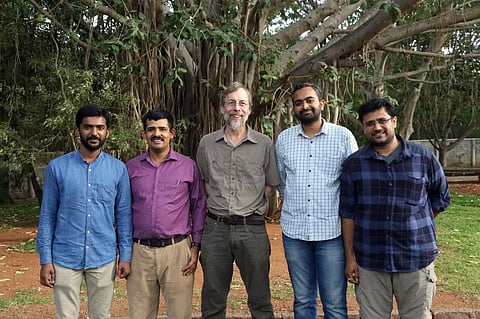

When the Hollywood movie Spider-Man was released, audience members across all the age groups were fascinated to see a man who could actually climb buildings using spider webs. Some even went on to study spiders in detail to find our whether spider-man could be made a reality. But even before the release of this movie, spiders were widely studied across the globe. It's just that we were ignorant to know about their role in the environment. Saaliga, a group of like-minded people from different parts of Karnataka came together to create awareness about spiders and their role in the environment.
Dr Abhijith APC, Vipin Baliga, Sumukha Javagal and Pavan Ramachandra are into different professions, but they are share a common interest -- preserving spiders. Abhijith, who is a Homeopathy doctor by profession says, "In 2017, we formed this group called Saaliga which means spider in Kannada. Every year, we conduct several activities to create awareness on spiders. 'Spider meet' is the most popular among them. Anyone can participate in this meet. There are different activities including classroom sessions where each one of us talks about the different families and diversity of spiders. We also have a spider walk because it is only during the night that spiders come out to consume insects. Similarly, the next day morning, we have a spider walk which takes place at the Indraprastha Organic Farm in Mysuru."
Apart from the spider meets that Saaliga conducts, the group also exhibits some interesting photographs of spider behaviour which was well appreciated. "These photos are captured from different parts of Karnataka and there are 200 different types of spiders in our photo collection. Out of these 200 types, we find at least 25-30 types in our surroundings. In order to tell people that these spiders are harmless and there is no need to kill them, we have published a book called Backyard Spiders which is available both in English and Kannada. In order to make it interesting for kids, this book has pictures of spiders belonging to the families of Salticidae (jumping spiders), Thomisidae, Sparassidae, Pholcidae, Lycosidae and Araneidae. These are the families under which these spiders are commonly classified," he says.
Role of spiders
Usually, farmers use chemical fertilisers to control pests in agricultural land. But these eight-legged creatures are the best pest controllers in any farm. According to Abhijith, spiders usually come out at night in search of food and consume at least four to five different types of insects. He explains, "For example, if there is a one acre of land, there will be a minimum of one lakh spiders and it can control at least four lakh insects per day. Imagine if there is no spider, the population of insects will increase which will lead to destruction of food. Apart from this, spiders love to feed on mosquitoes. They are the best mosquito repellants we have in nature. We give all this information to the people who attend our spider meet. So the next time they see a spider, they will not kill it and inform others about these facts."
Explaining some interesting facts about spiders, he adds, "Many believe the myth that spiders are insects, which is wrong. Spiders are classified under a separate order called Araneae. When compared to humans or any other animals, spiders are the largest consumers of food. While human being consumes 400 million tonnes of food per year, blue whales consume 200 tonnes of food per year and spiders consume 800 million tonnes of food (insects) per year. There are around 48,000 types of spiders in the world out of which 1,900 different types of spiders are found in India and are classified under 120 different families." So the next time you want to know more about spiders, just reach out to Saaliga and hear what they have to say
